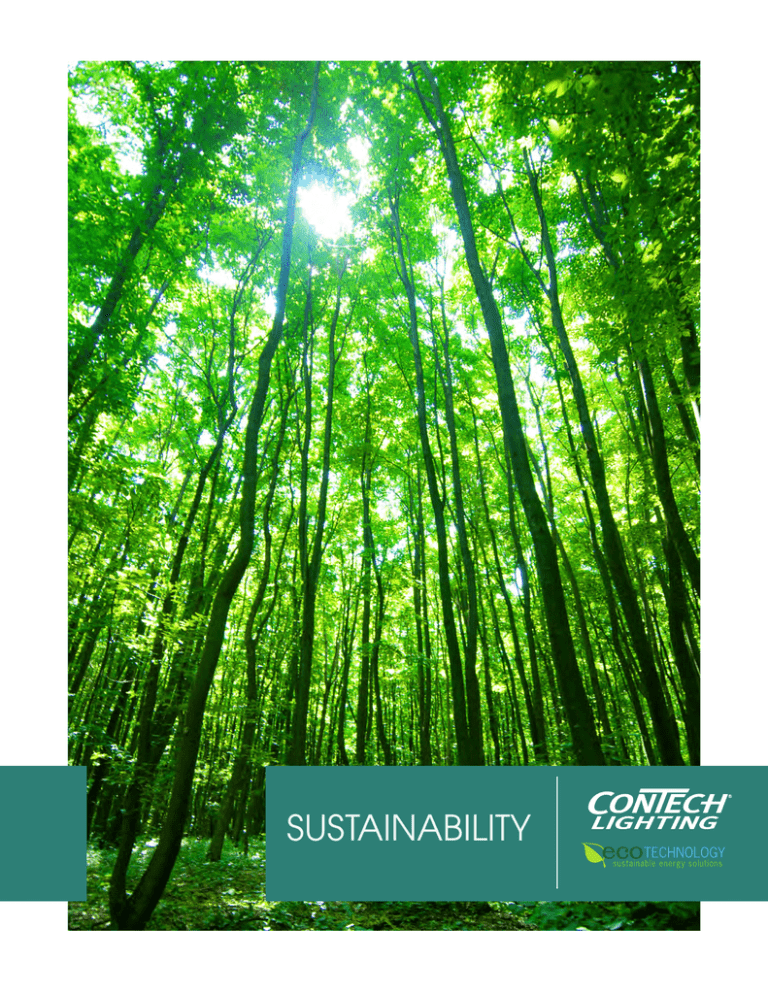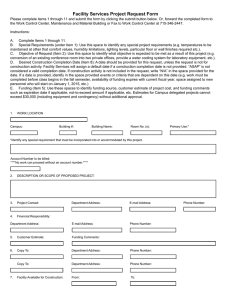SUSTAINABILITY
advertisement

SUSTAINABILITY In 1980, a company named Conservation Technology, Ltd. was founded with the mission of offering products that would help conserve energy. Today, that same company, better known as ConTech Lighting, continues its more than 30 year mission of conservation and protection of the environment by offering sustainable energy solutions called EcoTechnology. SUSTAINABILIT Y At ConTech Lighting, our commitment to the environment is as important as our commitment to innovation, quality and our customers. We believe that lighting can be environmentally responsible and energy efficient, while providing high-quality performance and outstanding aesthetic design. EcoTechnology applies to our daily operation as well as to our products; from materials, manufacturing and transportation to the disposal process for our products and by-products. Quality sustainable lighting is a balance of art and science. ConTech Lighting offers many energy saving lighting solutions that meet our customers’ performance and energy needs with the least impact on our physical environment. We realize that lighting can account for up to 50 percent of a buildings total energy demand so anything we do to make more efficient lighting fixtures will have a big impact on helping to protect the environment and reduce energy bills. That’s why ConTech has made a powerful commitment to not just make lighting better, but to make our environment better, too. The IALD (International Association of Lighting Designers) defines sustainable lighting design as meeting the qualitative needs of the visual environment with the least impact on the physical environment. At ConTech Lighting, we believe that lighting can be energy efficient while providing high-quality performance and outstanding aesthetic design. With the latest technology and correct application, it is possible to cut energy costs and improve lighting quality to increase the productivity of your space; we call this EcoTechnology. The EcoTechnology mission applies to our products as well as our daily operations; from materials, manufacturing and transportation, to the disposal process of our products and by-products. Quality lighting is not just about performance; it is also about energy management. Energy efficient lighting is a competitive tool. At ConTech Lighting, we continually evolve and expand our LED, Ceramic Metal Halide, Compact Fluorescent, and Incandescent product lines to be more energy efficient while maintaining the highest quality and efficacy. CONTECH SOLUTIONS STOPAIRE® As lighting and energy costs keep rising, lighting fixtures play an important role in energy consumption. Not only is the electricity used to power each fixture a consideration but also each fixture’s effect on heating and air conditioning costs. StopAire® recessed housings by ConTech Lighting are engineered to minimize lighting’s effects on heating and cooling costs. StopAire fixtures cut down or prevent air leakage by sealing all possible air leakage points through the recessed housing into ceiling or attic space. Additionally, these sealed housings can be covered with insulation. ENERGY STAR Using energy-efficient lighting fixtures in buildings not only delivers immediate cost savings but also better system efficiency; offering a sustained productivity increase for even greater value. ConTech features many ENERGY STAR qualified fixtures; the ENERGY STAR label is a widely recognized industry qualification awarded to products for energy efficiency. CUSTOM LABEL In order to help meet the power requirements of energy codes such as ASHRAE/IESNA 90.1, ConTech Lighting offers a Custom Labeling Program. This allows fixture rating labels to reflect the actual specified wattage rather than the maximum rating of the selected fixture. In cases where conformance to unit-power density requirements becomes a design challenge, this labeling option can help meet design requirements. As an example, a 75W PAR30 fixture may be relabeled with a 50W maximum rating resulting in a 25W savings on your energy calculations. To participate in this service please contact your ConTech Lighting Sales Representative. California Title 24 ENERGY STAR Title 24 was introduced in 1978 with the goal of reducing energy use. It addresses the energy efficiency of both residential and non-residential buildings in the state of California. Title 24 includes mandates for limiting the allowed lighting power (in watts) installed in the building, basic equipment efficiency, mandatory lighting controls, and the use of high efficacy fixtures. ENERGY STAR is a joint program between the U.S. Environmental Protection Agency and the U.S. Department of Energy to help save money and protect the environment through energy efficient products and practices. The ENERGY STAR program has boosted the adoption of energy efficient products, practices, and services through valuable partnerships, objective measurement tools, and consumer education. Lighting products approved to carry the ENERGY STAR label use the most energy efficient technology available. www.energy.ca.gov/title24 www.energystar.gov IECC The International Energy Conservation Code® is the second of the two primary baseline energy codes that may be adopted by state and local governments. The IECC was introduced in 1998 to address energy efficiency in both residential and commercial buildings. Updated about every three years, this code addresses energy conservation requirements for all aspects of energy use including heating and ventilation, lighting, water heating, and power usage for appliances and building systems. www.iccsafe.org LEED® LEED, Leadership in Energy and Environmental Design, is a product of the U.S. Green Building Council, transforming the way environments are designed, constructed, and operated. An internationally recognized program, LEED is a voluntary, consensus based standard for promoting sustainable design. It gives designers a list of best practices, which in turn earn project points toward certification. Practices include minimizing energy, daylight and views, controls, and light pollution. www.usgbc.org ANSI/ASHRAE/IESNA Standard 90.1 Standard 90.1 is one of the two primary baseline energy codes that may be adopted by state and local governments. The 1999 version of this code is the Federal government’s minimum standard that applies to commercial buildings, including multi-family high-rise buildings. This code is updated about every three years, and it’s provisions aim to limit the watts that can be used for lighting and establish minimum control requirements. Designers should always consult local codes and standards for where they are working. Green globes is a nationally recognized green rating assessment, guidance and certification program. It delivers an online assessment protocol, rating system and guidance for green building design, operation and management. It is interactive, flexible and affordable, and provides market recognition of a building’s environmental attributes through third-party verification. www.ashrae.org http://www.greenglobes.com/ ANSI/ASHRAE/USGBC/IESNA Standard 189.1 Standard 189.1 provides minimum requirements and guidance for designing, building, and operating high-performance green buildings. This standard sets the foundation for green buildings by addressing site sustainability, water use efficiency, energy efficiency, indoor environmental quality, and the building’s impact on the atmosphere, materials and resources. This standard applies to new buildings and their systems, new portions of buildings and their systems, and new systems and equipment in existing buildings for commercial buildings, including multi-family high-rise buildings. www.ashrae.org/greenstandard Green Globes EPAct 2005 The Energy Policy Act of 2005 is a tax incentive program for lighting and building efficiencies. It is designed to reduce the initial cost of investing in energy-efficient lighting and other building systems. Projects that meet Standard 90.1-2004 (or stricter) and attain LEED certification will most likely qualify for some incentive. www.lightingtaxdeduction.gov Codes, Standards, & Rating Systems Commercial and residential buildings in the United States consume nearly 70% of the nation’s electricity and account for one-third of the nation’s greenhouse emissions. Energy codes are put in place by Federal, state, and local governments to conserve energy to reduce these statistics. They set forth minimum requirements for energy efficient design and construction for new and renovated buildings. The first energy codes were the American Society of Heating, Refrigerating and Air Conditioning Engineers (ASHRAE) 90-77 and the Model Energy Code (MEC) 1983. In 2005, the Federal government implemented the Federal Energy Policy Act, which required state energy regulations to be at least equal to the provisions set forth in the ANSI/ASHRAE/IENSA Standard 90.1-1999. Each of these codes have undergone significant improvements and are updated on a three-year cycle. Now, more than half of the United States is using more recent and more restrictive versions of Standard 90.1, while some states, such as California, have developed their own codes. Energy Codes are the “letter of the law” and must be followed. Each state has their own set of energy codes. Energy Standards are just that, standard practices, or options, often referenced to by codes. Energy Rating Systems, such as Green Globes and LEED®, are purely voluntary, and are privately or government owned. es D igned a SA esi D gned a SA esi D gned a esi D gned a SA ted in the Prin U nd SA ted in the Prin U nd ted in the Prin U nd Designed and Printed in the USA es D igned a Designed and Printed in the USA ted in the Prin U nd SA esi D gned a Designed and Printed in the USA ted in the Prin U nd esi D gned a SA esi D gned a ted in the Prin U nd 725 LAndwehr Road Northbrook, Illinois 60062 Designed and Printed www.contechlighting.com in the USA ted in the Prin U nd SA SA ted in the Prin U nd Designed and Printed in the USA Designed and Printed in the U.S.A. All specifications subject to change without notice. LITSUS






